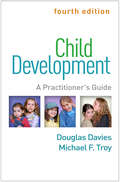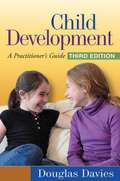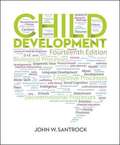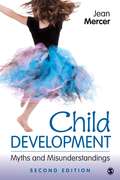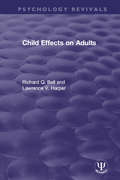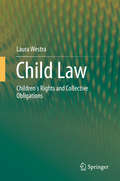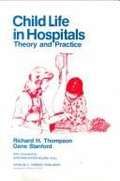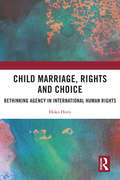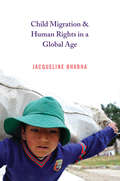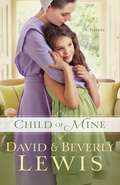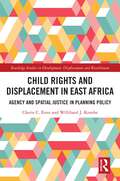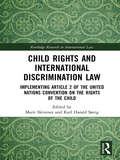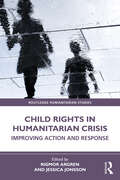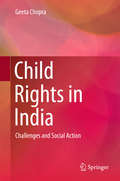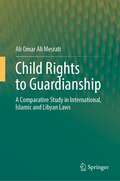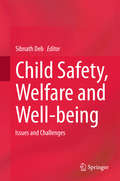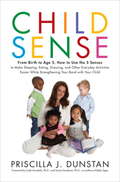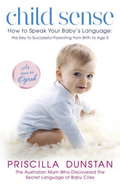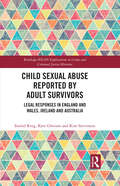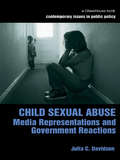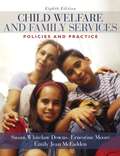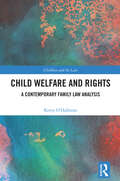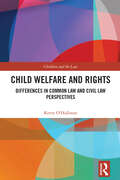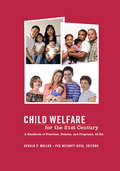- Table View
- List View
Child Development, Fourth Edition: A Practitioner's Guide (Clinical Practice with Children, Adolescents, and Families)
by Douglas Davies Michael F. TroyNow in a revised and updated fourth edition, this trusted text and professional resource provides a developmental framework for clinical practice. The authors examine how children's trajectories are shaped by transactions among family relationships, brain development, and the social environment. Risk and resilience factors in each of these domains are highlighted. Covering infancy, toddlerhood, the preschool years, and middle childhood, the text explores how children of different ages typically behave, think, and relate to others. Developmentally informed approaches to assessment and intervention are illustrated by vivid case examples. Observation exercises and quick-reference summaries of each developmental stage facilitate learning. New to This Edition *Incorporates a decade's worth of advances in knowledge about attachment, neurodevelopment, developmental psychopathology, intervention science, and more. *Toddler, preschool, and school-age development are each covered in two succinct chapters rather than one, making the book more student friendly. *Updated throughout by new coauthor Michael F. Troy, while retaining Douglas Davies's conceptual lens and engaging style.
Child Development, Third Edition
by Douglas DaviesThis widely used practitioner resource and course text provides an engaging overview of developmental theory and research, with a focus on what practitioners need to know. The author explains how children's trajectories are shaped by transactions among early relationships, brain development, and the social environment. Developmental processes of infancy, toddlerhood, the preschool years, and middle childhood are described. The book shows how children in each age range typically behave, think, and relate to others, and what happens when development goes awry. It demonstrates effective ways to apply developmental knowledge to clinical assessment and intervention. Vivid case examples, observation exercises, and quick-reference tables facilitate learning. New to This Edition Incorporates the latest research on the developing brain, attachment, risk and protective factors, and all domains of development. Neuroscience information is more fully integrated throughout. New material on preadolescence, foster care, trauma, and social policy. Expanded discussions of developmentally appropriate interventions, including new case examples.
Child Development: An Introduction (Fourteenth Edition)
by John W. SantrockThorough. Accurate. Reliable. Engaging. These are just a few of the words used by adopters and reviewers of John Santrock's Child Development. The new topically-organised fourteenth edition continues with Santrock's highly contemporary tone and focus, featuring over 1,000 new citations. The popular Connections theme shows students the different aspects of children's development to help them better understand the concepts. Used by hundreds of thousands of students over thirteen editions, Santrock's proven learning goals system provides a clear roadmap to course mastery.
Child Development: Myths and Misunderstandings (2nd Edition)
by Jean MercerIn Child Development: Myths and Misunderstanding Second Editions, Jean Mercer uses intriguing vignettes and questions about children and families to guide readers in thinking critically about 59 common beliefs. Each essay confronts commonly held misconceptions about development, encouraging students to think like social scientists and to become better consumers of media messages and anecdotal stories.
Child Effects on Adults (Psychology Revivals)
by Richard Q. Bell Lawrence V. HarperIt is usual to consider the effects parents have on children; this title, originally published in 1977, reverses the focus and reveals a subject every bit as important and interesting. The authors, both professional psychologists, present their findings under three major headings – "History", "Theories and Research Approaches" and "Concepts and Findings" – that discuss the social, psychological, and biological influences children exert on parents. Bell and Harper oppose the "intellectual apartheid" that prevents behavioural scientists from investigating "the continuity of interaction processes from other animals to man" and include substantial research findings in mammalian biology to show more precisely the reciprocal relations between parents and their offspring. Their "bidirectional approach" to the study of child-rearing is meant to offset empirical prejudices that had so far dominated child-care sciences at the time.
Child Law: Children's Rights and Collective Obligations
by Laura WestraChild Law starts with the question "Who is the Child?" In direct contrast to the CRC, which calls for putting the interests of the child first in all policies dealing with children, it appears that the interests of others are the major consideration de facto. In law, children's right to protection is severely limited by the presence of a maximum age limit, with no consideration of the starting point: current and ongoing scientific research has demonstrated the effects of this non-consideration in a number of abnormalities and diseases, not only in children, but in adults and the elderly. The WHO has published a number of studies to that effect and the 2012 Report on Endocrine Disruptors more than confirms this claim. This and other scientific insights that have largely been ignored show the flaws and inadequacies of the legal regimes intended to protect children, in a number of areas, from the basic public health to the right to normal development; child labor law conventions; in conflict situations; as a result of climate and other events; children as illegal migrants and as inmates in prison camps.
Child Life in Colonial Days
by Alice Morse EarleOriginally published in 1899, this book is a social history of the life of children in colonial America. The author conducted extensive research, examining letters and diaries, church and court records, newspapers, early textbooks, and objects such as toys and household implements to gather information about child-rearing practices before the Revolution. Topics include schooling, religious training, discipline, work, games and pastimes, and folkways pertaining to flowers. The 1993 introduction helps to put this work in context.
Child Life in Hospitals: Theory and Practice
by Richard H. Thompson Gene StanfordChild Life in Hospitals presents an exciting and fresh approach to child life programming. The authors demonstrate through selected case studies, pertinent bibliographical resources, and personal experience the emotional needs of the hospitalized child and his or her family, while confronting the reader with the realities of administrating a child life program.
Child Marriage, Rights and Choice: Rethinking Agency in International Human Rights
by Hoko HoriiThis book addresses the issue of agency in relation to child marriage. In international campaigns against child marriage, there is a puzzle of agency: while international human rights institutions celebrate girls’ exercise of their agency not to marry, they do not recognize their agency to marry. Child marriage, usually defined as ‘any formal marriage or informal union where one or both of the parties are under 18 years of age’, is normally considered as forced – which is to say that it is assumed assuming that are not capable of consenting to marriage. This book, however, re-examines this assumption, through a detailed socio-legal examination of child marriage in Indonesia. Eliciting the multiple competing frameworks according to which child marriage takes place, the book considers the complex reasons why children marry. Structural explanations such as lack of opportunities and oppressive social structures are important, but not exhaustive explanations. Exploring the subjective reasons by listening to children’s perspectives, their stories show that many of them decide to marry for love, desire, to belong to the community, and for new opportunities and hopes. The book, then, demonstrates how the child marriage framework – and, indeed, the human rights framework in general – is constructed on too narrow a vision of human agency: one that cannot but fail to respect and promote the agency of all, regardless of gender, race, religion, and age. This book will be of interest to scholars, students, and practitioners in the areas of children’s rights, legal anthropology, and socio-legal studies.
Child Migration and Human Rights in a Global Age (Human Rights and Crimes against Humanity #25)
by Jacqueline BhabhaThe first comprehensive look at the global dilemma of child migrationWhy, despite massive public concern, is child trafficking on the rise? Why are unaccompanied migrant children living on the streets and routinely threatened with deportation to their countries of origin? Why do so many young refugees of war-ravaged and failed states end up warehoused in camps, victimized by the sex trade, or enlisted as child soldiers? This book provides the first comprehensive account of the widespread but neglected global phenomenon of child migration, exploring the complex challenges facing children and adolescents who move to join their families, those who are moved to be exploited, and those who move simply to survive.Spanning several continents and drawing on the stories of young migrants, Child Migration and Human Rights in a Global Age provides a comprehensive account of the widespread and growing but neglected global phenomenon of child migration and child trafficking. It looks at the often-insurmountable obstacles we place in the paths of adolescents fleeing war, exploitation, or destitution; the contradictory elements in our approach to international adoption; and the limited support we give to young people brutalized as child soldiers. Part history, part in-depth legal and political analysis, this powerful book challenges the prevailing wisdom that widespread protection failures are caused by our lack of awareness of the problems these children face, arguing instead that our societies have a deep-seated ambivalence to migrant children—one we need to address head-on.Child Migration and Human Rights in a Global Age offers a road map for doing just that, and makes a compelling and courageous case for an international ethics of children's human rights.
Child Of Mine
by Beverly Lewis David LewisFrom Bestselling Authors David & Beverly Lewis: Flight instructor Jack Livingston has been raising his eight-year-old adopted niece, Natalie, since the accident that took her parents' lives. When he travels, Natalie is tenderly cared for by her Amish nanny, Laura Mast, who loves the little girl as her own. Eight excruciating years ago, Kelly Maines's baby was kidnapped. Determined to find her child, Kelly has tirelessly pursued every lead to its bitter end. And now, with the clock ticking, one last clue from a private investigator ignites a tiny flame of hope: Just a few miles away lives a young girl who matches the profile. Can this be, at long last, Kelly's beloved daughter?
Child Rights and Displacement in East Africa: Agency and Spatial Justice in Planning Policy (Routledge Studies in Development, Displacement and Resettlement)
by Cherie C. Enns Willibard J. KombeFocusing on the intersection of spatial justice, child rights, and planning policy, this book investigates the challenges of resettlement in East Africa, where half of those displaced are children. The challenges created by displacement and resettlement are often considered from an adult-centric perspective by planners and humanitarian and development experts. The spatial injustice of displacement and resettlement, the agency of children, and the application of tools such as Child Participatory Vulnerability Index (CPVI) is siloed, commonly overlooked, or discounted. This book uses a CPVI and rights-based assessment of land-use policies, to investigate resettlement due to conflict and settlement in northern Uganda, floods due to climate change in Dar es Salaam, Tanzania, and urban to rural migration of children due to the aids pandemic in Western Kenya. Case studies from over a decade of field research are integrated with examples from applied planning projects and policy development in the East Africa region. This book uses spatial justice theory to show how child-friendly planning approaches can positively promote child rights in the context of resettlement. Providing important insights on how to enact child-friendly planning in informal settlements, refugee camps, and displacement camps, this book will be of interest to planning and development professionals, and researchers across the fields of children's rights, Development Studies, Planning, and African Studies.
Child Rights and International Discrimination Law: Implementing Article 2 of the United Nations Convention on the Rights of the Child (Routledge Research in International Law)
by Marit Skivenes Karl Harald SøvigSocieties and states are at a crossroad in how children are treated and how their rights are respected and protected. Children´s new position and their strong rights create tensions and challenge the traditional relationships between family and the state. The United Nations Convention on the Rights of the Child was adopted unanimously by the General Assembly of the United Nations in 1989 and came into force in 1990. Article 2 places states under an obligation to accord primacy to the best interests of the child in all actions concerning children and to ensure and regulate child protection. This book offers a comparative and critical analysis of the implementation of Article 2 of the United Nations Convention on the Rights of the Child. In order to examine how Article 2 is being implemented, it is essential to have a sound understanding of the obligations it emposes. The opening chapters will explore the precise content of these obligations in terms of the legislative history of the text, its underlying philosophy, its amplification by the United Nations Committee on the Rights of the Child, and subsequent authoritative interpretations of it by courts around the world. The book will then drill down into the conceptual and theoretical challenges posed by the very nature of the obligations and will offer in-depth exploration of the long-running ‘rights v welfare’ debate that has always presented something of a challenge in giving effect to children’s rights. Contributors are leading academics in the children’s rights field drawn from a wide range of countries and jurisdictions worldwide, including those with common law, civilian and mixed traditions. Disciplines represented in the book include law, psychology, political science, childhood studies, social work and anthropology. By drawing together the various facets of Article 2 and analysing it from a range of perspectives, the volume provides a coherent and comprehensive inter-disciplinary analysis on discrimination and the rights of the child.
Child Rights in Humanitarian Crisis: Improving Action and Response (Routledge Humanitarian Studies)
by Rigmor Argren Jessica JonssonThis book demonstrates how a focus on children’s rights can help practitioners to safeguard children during humanitarian crisis. Child Rights in Humanitarian Crisis focuses on understanding and advancing child rights through practical applications of a child rights perspective in crisis response. The book establishes that with accessible, child-friendly participatory means, crisis response can improve from a child rights perspective and even advance children’s rights whilst also supporting and furthering the development of a child’s agency. The volume presents the reader with a clear focus on children from a range of backgrounds, including those most marginalised, such as children with disabilities. Drawing on expertise from the field as well as academia, and providing practical examples which link case studies to legal policies in recent and protracted humanitarian responses, such as in Turkey and at the Lithuania–Belarus border, this book is a treasure trove of advice from some of the humanitarian and development sector’s most experienced professionals. Combining insights from both research and practice, this book will be an essential read for humanitarian students and practitioners.
Child Rights in India: Challenges and Social Action
by Geeta ChopraThe book is a comprehensive compendium on child rights in India from a child development perspective. It discusses the challenges that Indian children face for survival, development and education, especially if they are marginalized through disability, lack of care, and poverty. The major issues expounded by the author in relation to rights are infant and child survival, early child development, street and working children, children in conflict with law, children with disabilities, child trafficking and child sexual abuse. The author goes further to delve into the causes, among which are high population, poverty, migration, illiteracy, poor legislation and deep-rooted social norms and behaviour. The book presents the existing policy and legal framework in India for each of these issues. The broad purpose of the book is to comprehensively discuss the roadblocks that the marginalized child in India faces, to understand the causes of these roadblocks and to evaluate government and civil society action for children in India.
Child Rights to Guardianship: A Comparative Study in International, Islamic and Libyan Laws
by Ali Omar MesratiThis book examines how local cultures affect the interpretation of international human rights law. This book explores the Islamic legal system in its approach to the concept of guardianship and, more specifically, the approach of the Libyan legal system through a study of existing legislation and Libyan High Court (LHC) interpretation as revealed in its decisions. This book aims to show how the cultural background affects the interpretation of international human rights in domestic legal systems. This book makes a worthy contribution to promoting greater understanding of the cultural dimensions in operation in both the formulation and particularly the application of international law in Libya as elsewhere. This is an area of research which is, as a whole, one worthy of further development and examination. The book includes case analysis of important Libyan High Court rulings which have been gathered by the author and officially translated, analysed, and discussed from the three lenses namely; Libyan Law, Islamic Law, and International Law. In turn, this book is the first of its kind and unique in the field of Islamic and International Law. This book also includes detailed analysis of the correspondence between the Libyan High Court and the UN Committee on the Rights of the Child. Further, this book provides solutions and comprehensive and practical recommendations that satisfy both International standards and local Islamic and Libyan culture. This is an ever evolving and a current area of interest internationally, this unique book enriches the field and continues the conversation and provides practical sustainable solutions.
Child Safety, Welfare and Well-being: Issues and Challenges
by Sibnath DebThis volume presents the unique features of child abuse and neglect and discusses proposed as well as experimented protective measures to create awareness about child rights and their implementation. Divided into four sections, the volume discusses (a) the nature and prevalence of child abuse and neglect, risk factors and impact; (b) issues pertaining to child rights with regard to nutrition, health and education; (c) rights of children with disabilities, HIV/AIDS, and in circumstances like disaster and adoption; and (d) field-based experiences of researchers in protecting child rights and preventing child abuse. The most important contribution of this volume is in providing an analysis of the current legal scenario of child protection, emphasizing the rights of different sections of vulnerable children. Professionals and academics specializing in this area from different academic backgrounds and regions have contributed chapters to this volume, creating a global and multidisciplinary forum for discussion. This volume is important for a wide range of professionals and researchers from the social sciences, law, medicine, and behavioral sciences. It is also beneficial for policy makers and law enforcement agencies working with children.
Child Sense: From Birth to Age 5, How to Use the 5 Senses to Make Sleeping, Eating, Dressing, and Other Everyday Activities Easier While Strengthening Your Bond with Your Child
by Priscilla J. DunstanThe result of eight years of groundbreaking research, this accessible guide teaches a new way of parenting, custom-designed for each child's unique personality.
Child Sense: How to Speak Your Baby's Language: the Key to Successful Parenting from Birth to Age 5
by Priscilla DunstanMake sleeping, eating, dressing and other everyday activities easier, while strengthening your bond with your child. Renowned 'baby listenener' Priscilla Dunstan reveals how each of us is born with one dominant sense mode - seeing, hearing, touching, or tasting and smelling. And shows how understanding this fact can help resolve most of the everyday conflicts that plague families, and help bridge the communication gap between you and your child. A one-stop guide to the first five years of life, read Child Sense to discover ... * What makes your baby happy * Simple techniques for dealing with everyday problems * How best to interpret your child's behaviour and maximise their potential for success and happiness in life.
Child Sexual Abuse Reported by Adult Survivors: Legal Responses in England and Wales, Ireland and Australia (Routledge SOLON Explorations in Crime and Criminal Justice Histories)
by Kim Stevenson Sinéad Ring Kate GleesonChild Sexual Abuse Reported by Adult Survivors is a wide-ranging and timely critical history and analysis of legal responses to ‘historical’ or ‘non-recent’ child sexual abuse (NRCSA) in England and Wales, Ireland and Australia, each of which represents an evolving and progressive approach to this important and complex issue. The book examines the emergence of NRCSA as a distinctive social, political and legal phenomenon in each country and explores the legal responses developed to address its unprecedented challenges. Courts and parliaments in each country have reformed existing doctrine and practice and have created new ways of holding state and private actors accountable and new ways of addressing survivors’ injuries. Criminal law, tort law, public inquiries and state reparations have all been to the forefront of these new legal responses, which have transformed law’s engagement with NRCSA survivors and understandings of justice itself. However, despite this undeniable progress, the book identifies ways in which the legal responses developed in each country fail to deliver accountability and recognition to NRCSA survivors and argues that such failures betray the law’s inherent ambivalence to delivering justice for these survivors. Creating new insights into legal responses to this complex contemporary legal, social and political problem, this book will be of great interest to academic lawyers, political scientists and historians, as well as those working on related topics in criminology, sociology, social policy, cultural studies and gender studies.
Child Sexual Abuse: Media Representations and Government Reactions (Contemporary Issues in Public Policy)
by Julia DavidsonChild Sexual Abuse critically evaluates the development of policy and legislative measures to control sex offenders. The last fifteen years has seen increasing concern on the part of the government, criminal justice agencies, the media and the public, regarding child sexual abuse. This concern has been prompted by a series of events including cases inviting media attention and involving the abduction, sexual abuse and murder of young children. The response to this wave of child sexual abuse revelation has been to introduce increasingly punitive legislation regarding the punishment and control of sex offenders (sex offenders are the only group of offenders in British legal history to have their own act), both in custody and in the community. But this response, it is argued here, has developed in a reactionary way to media and public anxiety regarding the punishment and control of sex offenders (who have abused children) and the perceived threat of such offenders in the community.
Child Welfare and Family Services: Policies and Practice (Eighth Edition)
by Susan Downs Ernestine Moore Emily Jean McfaddenIntended for use in collaborative programs bringing together public child welfare agencies and schools of social work, this textbook takes a deliberately broad approach to child services. Chapters concentrate on topics like rights and responsibilities, the prevention of maltreatment, day care and child development programs, family income security, court intervention, protection from neglect and abuse, family preservation, foster care, adoption, delinquency, and professional responsibilities. Annotation ©2004 Book News, Inc., Portland, OR (booknews.com)
Child Welfare and Rights: A Contemporary Family Law Analysis (Children and the Law)
by Kerry O'HalloranThis book focuses on the role and content of the principle of the welfare interests of the child, considers the extent to which the principle has changed following its varied elevation by the introduction of paramountcy and reviews the distinction between welfare interests and rights.Providing an updated record of developments in the framework of relevant international law, the book assesses the contemporary relevance of established and emerging themes in the flow of cases dealing with the welfare interests and rights of children in England, Wales, Ireland, the U.S., Canada, Australia, New Zealand, France and Germany. By identifying and analysing the functions of the principle in hybrid proceedings (including adoption from state care and commercial surrogacy) the book completes the analysis of the law relating to children in public (care and protection) and in private (divorce, custody, etc.) family law as a whole, revealing characteristic jurisdictional differences and facilitating a comparative assessment of their significance. By examining the international framework of legislation and related caselaw it identifies and assesses unfolding themes in the law relating to children. In addition to a digest of international cases and legislation that identifies and tracks the role of this principle in civil and criminal law, lawyers, academics and other researchers will find a wealth of information on how it has evolved to reflect corresponding changes in society.
Child Welfare and Rights: Differences in Common Law and Civil Law Perspectives (Children and the Law)
by Kerry O'HalloranThis book examines jurisdictional differences in the role of the principle of the welfare interests of the child in common and civil law and focuses on differences within these two legal traditions.By identifying and analysing the functions of the principle both in the public and private sector of family law, the book compares and contrasts different jurisdictions and assesses their capacity to implement children’s welfare interests and rights. Covering a variety of topics including child abuse and neglect, state care, adoption and reproductive rights and family breakdown, the book demonstrates how welfare interests and rights can be balanced to create a coherent framework for family law.In addition to providing an up-to-date digest of cases and legislation, the book will be of interest to researchers in the field of child welfare and family law.
Child Welfare for the Twenty-first Century: A Handbook of Practices, Policies, and Programs
by Peg McCartt Hess Gerald MallonThe Adoption and Safe Families Act (ASFA), which became law in 1997, elicited a major shift in federal policy and thinking toward child welfare, emphasizing children's safety, permanency, and well-being over preserving biological ties at all costs. The first edition of this volume mapped the field of child welfare after ASFA's passage, detailing the practices, policies, programs, and research affected by the legislation's new attitude toward care. This second edition highlights the continuously changing child welfare climate in the U.S., including content on the Fostering Connections Act of 2008.The authors have updated the text throughout, drawing from real-world case examples and data obtained from the national Child and Family Services Reviews and emerging empirically based practices. They have also added chapters addressing child welfare workforce issues, supervision, and research and evaluation. The volume is divided into four sections—child and adolescent well-being, child and adolescent safety, permanency for children and adolescents, and systemic issues within services, policies, and programs. Recognized scholars, practitioners, and policy makers discuss meaningful engagement with families, particularly Latino families; health care for children and youth, including mental health care; effective practices with LGBT youth and their families; placement stability; foster parent recruitment and retention; and the challenges of working with immigrant children, youth, and families.
